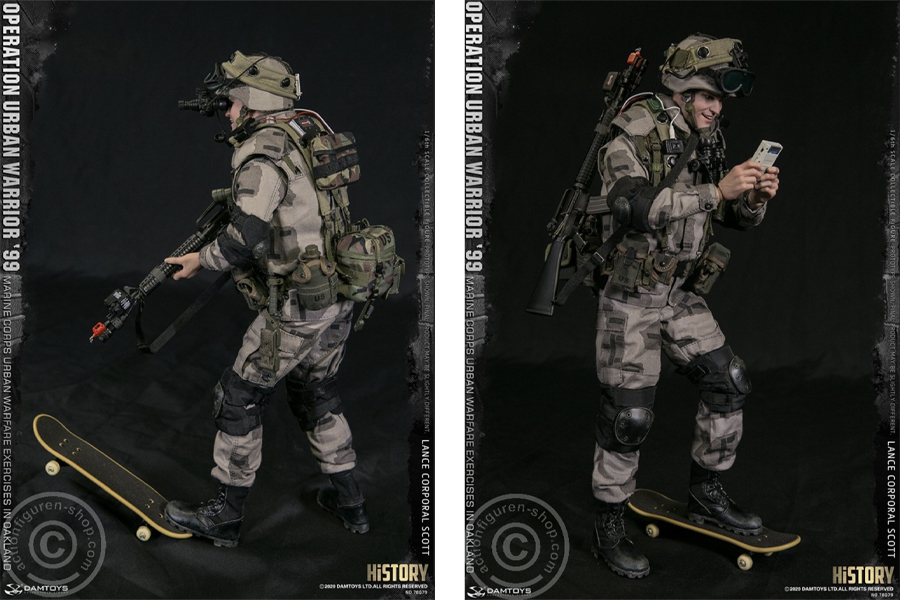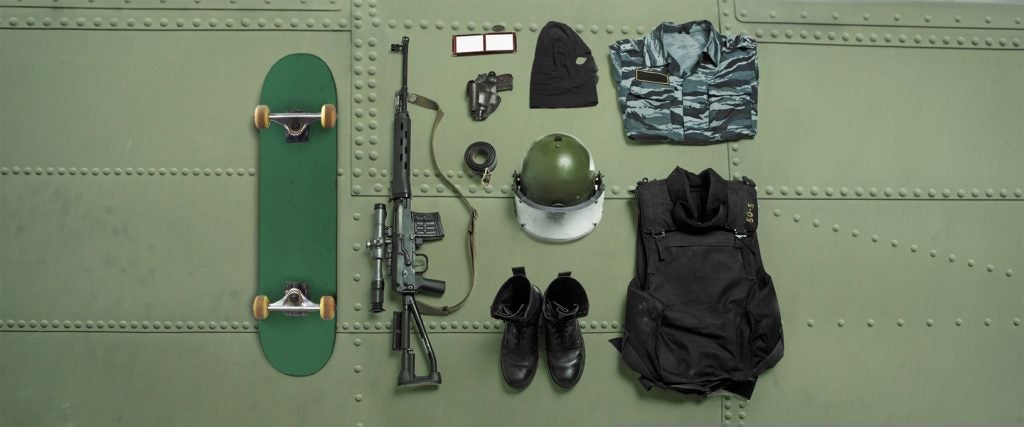It was the Ides of March 1999, when the U.S. Marine Corps invaded Oakland. Of course, it wasn’t a real invasion, but part of a military exercise dubbed “Operation Urban Warrior,” meant to show off the Marines’ newfound readiness for the “three-block war,” — i.e., armed conflict in urban areas.
A group of enormous Navy Landing Craft Air Cushions floated just above the chop of the bay. As the 88-foot long hovercrafts approached the former naval base at Alameda, there on the Oakland side of the water waited a hundred or so protesters. They carried 12-foot high paper-mache heads and cardboard helicopters as they shouted, “Child care, not warfare!” and “How many school books could Urban Warrior buy?” California Highway Patrol officers and Oakland police were also there to film the scene.
The protesters and their drum circle soon felt the mist of water clouds kicked up by two CH-53 Sea Stallion transport helicopters, loaded down with Marines. As the troops and their Humvees touched ground, there was one soldier among them who perfectly encapsulated the bizarre output of the new Marine Corps experimental weapons program. His name was Lance Corporal Chad Codwell of the 1st Battalion, 5th Marines, Charlie Company — although these days, he’s known simply as the Skateboarding Marine.
Yes, that image is real. And yes, the Marines really did try to turn skateboarding into a weapon of urban assault combat training.
It all started with General Charles Krulak, a Marine Corps commandant who was motivated to revamp the fighting force to prepare them for the challenges of the 21st century. Krulak was a man who took inspiration from history and the great military leaders of the bygone past. “Genghis Khan gave his commander’s intent,” he told the Washington Post at the time. “And then he had battle captains. Our platoon commanders are going to be the battle captains. And then the kids execute the tactic. It won’t be like the old days when, to pass gas, you had to have an order. Genghis Khan would communicate over long distances with outriders. But the riders would only do as much as report a shift in commander’s intent. That’s the way the world is going.”
The answer that the Marines came up with — Operation Urban Warrior — was a broad initiative of innovation and experimentation, as imagined by the military’s finest. The need for it first came to light in Somalia in 1993. During the Battle of Mogadishu, a number of highly trained Army Rangers were killed by Somali amateur soldiers in a brutal street fight after two helicopters were shot down. (You may know this battle from Black Hawk Down.) Not since Vietnam had U.S. fighting forces been involved in such heavily-armed urban combat. And not since Vietnam had they endured such an embarrassing loss on the world stage.
To be better prepared in the future, Krulak established the U.S. Marines Commandant’s Warfighting Laboratory, with the chief experimental campaign dubbed “Sea Dragon.” “We’re experimenting,” Krulak explained in the WaPo interview. “We’re ‘riding the dragon’ of change. Chinese proverb. I’ve got the Chinese character for ‘chaos’ from the I Ching on my wall in my office. Below, it says, ‘Chaos — where brilliant dreams are born. Before the beginning of great brilliance, there must be chaos. Before a brilliant person begins something great, she or he must look foolish to the crowd.’”
As part of their experiments, Marine Corps researchers played around with “limited objective experiments,” and created an EDM light show, but for combat, per the National Research Council. There was also a remote-controlled urban bulldozer, which the troops who tested it called the “bulldozer from hell.” (Apparently, the tech wasn’t totally worked out on that one.) Then there was the “airborne aerostat communications relay system,” which was just a fancy term for giant weather balloons that were tethered to the terrestrial operations. In one test, a giant weather balloon “broke from its tether during high desert winds and threatened Palm Springs, California.” Not great.
Last but not least, there was the “urban assault skateboard.” The reports from the Marines’ experiments with the weaponized skateboard tended to focus on the kneepads, which ultimately led researchers to find some success. “Although experimenting with industrial-quality knee and elbow pads for the urban combat troops was unsuccessful, it led to the use of the [commercial off-the-shelf] skateboard equipment that satisfied the requirement.”
Apparently, the Marines’ next-gen weapons designers and testers purchased skateboards off-the-shelf, painted them combat green and then tested their ability to offer new ways of “maneuvering inside buildings, in order to detect tripwires and sniper fire.” (Overall, the general consensus from soldiers seemed to be: “This would not have been a smart idea. Would it look cool? Fuck yeah, it would.”)
All of which brings us back to Lance Corporal Scott, aka the Skateboarding Marine. Believe it or not, that one image of him from the Oakland Urban Warrior exercise was enough to inspire an action figure (albeit with a new name — Lance Corporal Scott), complete with weaponized skateboard:

While the Skateboarding Marine was never deployed into real combat, there were two new tech components that originated under the Sea Dragon banner that proved very useful to the Marines. The Dragon Eye was a “portable unmanned aerial vehicle, which fit in a Marine’s backpack and [was] designed to help fighting forces ‘see over the next hill.’” Meanwhile, the “interim fast attack vehicle” was designed to replace Vietnam-era Jeeps. It proved such a success that a new version was just recently released — these days, it’s essentially a “highly modified version of the Mercedes G-Wagon.”
Successes and failures aside, it really should surprise no one that the Pentagon would take something like “Skate and Destroy” and attempt to turn it into a weapon. In an era when the U.S. military was routinely one step behind the asymmetrical warfare tactics of its adversaries, it’s no wonder that the contemporary Dr. Strangelove is basically the Steve Buscemi “How do you do, fellow kids?” meme.

